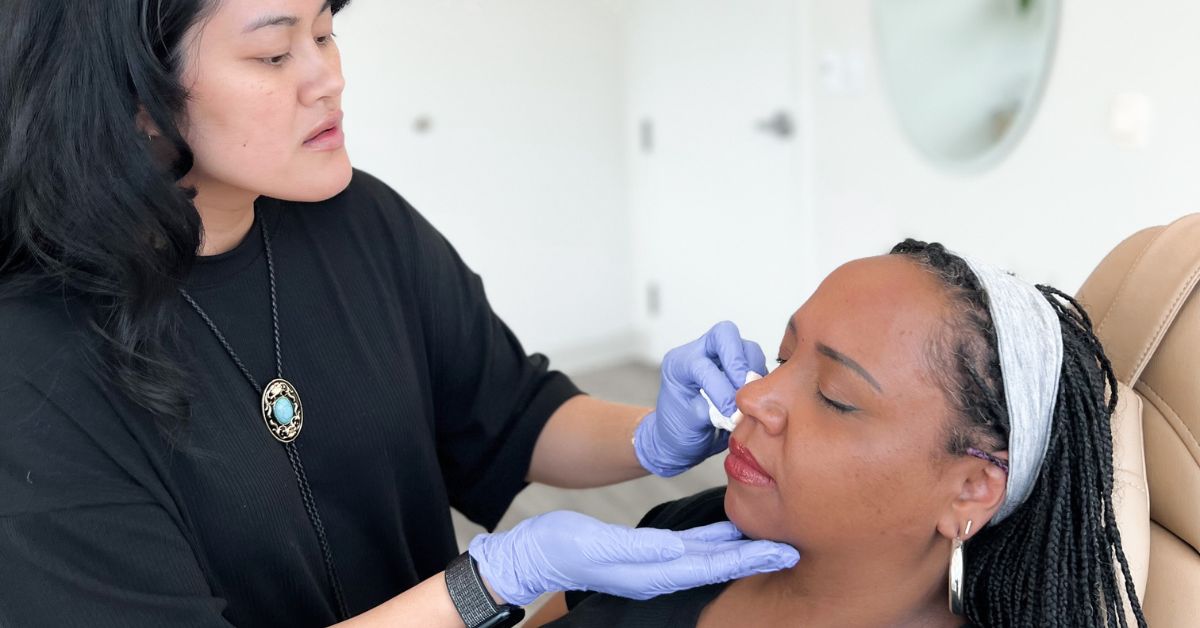The 15 Long-Term Effects of UV Rays on Skin

The sun presents more dangers than a painful sunburn. From aesthetic concerns to the truly dangerous possibility of skin cancer, read on and find out some of the long-term effects of UV rays on skin.
Premature Aging
One of the most well-known effects of prolonged UV exposure is premature aging. UV rays break down collagen and elastin, which are proteins responsible for keeping your skin firm and smooth. Over time, this causes the skin to lose its elasticity, leading to fine lines, wrinkles, and sagging. People who spend a lot of time in the sun without proper protection are more likely to experience premature aging. Protecting your skin early can delay these effects, but once the damage is done, reversing it becomes more challenging.
Sunspots and Hyperpigmentation
UV rays can lead to the development of sunspots, also known as age spots or liver spots. These small, flat, dark areas of skin appear in sun-exposed areas, such as the face, hands, and shoulders. Hyperpigmentation is another long-term effect, where patches of skin become darker than the surrounding area. This happens when UV rays increase melanin production, which is the skin’s defense mechanism against sun exposure. Although sunspots are generally harmless, they can affect the skin’s overall appearance.
Loss of Skin Elasticity
Continuous exposure to UV rays causes the skin to lose its natural elasticity, making it more prone to sagging and wrinkles. The degradation of collagen and elastin in the skin’s dermis layer leads to less supple skin that doesn’t bounce back like it used to. This is one of the earliest signs of UV damage and can become more noticeable with age. Without intervention, such as moisturizers and treatments to boost collagen, this loss of elasticity can become irreversible.

Thickened Skin (Solar Elastosis)
In some cases, long-term UV exposure results in a condition called solar elastosis. This causes the skin to thicken and develop a leathery texture due to the overproduction of abnormal elastin. This is particularly common in individuals with fair skin who spend excessive time in the sun without protection. Solar elastosis alters the skin’s appearance and texture, making it rough to the touch. Regular use of sunscreen can prevent the thickening of skin over time.
Freckles
While freckles are a genetic trait, UV exposure can cause more to appear or make existing freckles darker. They develop as a result of increased melanin production in certain areas of the skin. Unlike sunspots, which appear later in life, freckles are usually noticeable from a young age but can worsen with time and sun exposure. For people who want to prevent more freckles from forming, sun protection is key.
Immune Suppression
Many people are unaware that UV exposure can suppress the skin’s immune function. The skin serves as a first line of defense against infections and other harmful agents, but too much exposure to UV rays can weaken this protective barrier. This can make the skin more susceptible to infections, allergies, and certain skin conditions. Limiting sun exposure helps maintain the skin’s immune defense and reduces the risk of developing these problems.
Dryness and Dehydration
Extended time in the sun depletes the skin’s natural moisture barrier, leading to chronic dryness and dehydration. UV rays affect the outer layer of the skin, making it harder for the skin to retain moisture. As a result, the skin may appear flaky, rough, and irritated over time. Using moisturizers with SPF can help protect the skin from sun damage while keeping it hydrated.
Broken Blood Vessels (Telangiectasia)
UV rays can cause the small blood vessels just below the surface of the skin to rupture, leading to a condition known as telangiectasia. This results in red or purple “spider veins” that are visible on the skin, most commonly around the nose, cheeks, and legs. Broken blood vessels are difficult to treat once they develop and are often permanent. The best prevention is regular sun protection and minimizing prolonged sun exposure.
Increased Risk of Skin Cancer
Perhaps the most serious long-term effect of UV exposure is the increased risk of developing skin cancer. The sun’s UV rays damage the DNA in skin cells, which can lead to the development of cancerous growths. Skin cancers, such as basal cell carcinoma, squamous cell carcinoma, and melanoma, are linked directly to excessive UV exposure. Wearing sunscreen and protective clothing is essential to reducing this risk.
Changes in Skin Texture
Long-term UV exposure can alter the texture of the skin, making it appear rough, bumpy, or uneven. This happens as a result of the breakdown of collagen and elastin in the skin’s deeper layers. Over time, these textural changes can make the skin feel coarse and less smooth. Exfoliation and moisturizing can help to some extent, but prevention through sun protection is more effective in the long run.
Development of Fine Lines and Wrinkles
UV rays accelerate the formation of fine lines and wrinkles, particularly around areas like the eyes and mouth. The breakdown of collagen is a major factor in this process, as it is a key component in maintaining smooth skin. Repeated exposure to UV rays weakens the skin’s ability to repair itself, leading to deeper wrinkles over time. Sunscreen and anti-aging creams can help reduce the visibility of these signs of aging.

Uneven Skin Tone
UV rays can cause uneven skin tone, leading to areas of hyperpigmentation or dark spots. This unevenness can give the skin a blotchy appearance, especially in individuals with lighter skin tones. Even with minimal exposure, over time, this can accumulate and result in a more uneven complexion. Applying sunscreen daily and avoiding tanning beds can prevent these long-term effects on the skin.
Formation of Pre-Cancerous Lesions
Extended exposure to UV rays can cause pre-cancerous lesions known as actinic keratosis to form. These lesions are rough, scaly patches on the skin that can become cancerous if left untreated. Actinic keratosis is a common issue for people who spend a lot of time in the sun without protection, especially on areas like the face, ears, neck, and hands. Early detection and treatment are essential to prevent them from developing into more severe conditions.
Weakening of Skin’s Natural Barrier
UV exposure can weaken the skin’s natural barrier, making it more vulnerable to environmental stressors. This weakening leads to increased sensitivity to irritants, pollutants, and allergens. Over time, this can result in chronic skin conditions, such as eczema or dermatitis. Strengthening the skin’s barrier with moisturizing products and protecting it from UV rays can help minimize this damage.
Increased Sensitivity to Sunlight
Repeated UV exposure can cause the skin to become more sensitive to sunlight, a condition known as photosensitivity. This increased sensitivity makes the skin more prone to sunburn, rashes, and irritation. People with this condition need to be particularly cautious when spending time outdoors. Seeking guidance from aesthetic dermatology professionals can help manage and mitigate photosensitivity issues effectively.
Sun protection is key to preventing the long-term effects of UV rays on skin. Long-term exposure can lead to serious issues ranging from premature aging to skin cancer. Aesthetic dermatology solutions, such as targeted treatments and preventative care, can help address the damage caused by UV rays and maintain healthier skin over time.
The post The 15 Long-Term Effects of UV Rays on Skin appeared first on Skin by Lovely.
—————
Boost Internet Speed–
Free Business Hosting–
Free Email Account–
Dropcatch–
Free Secure Email–
Secure Email–
Cheap VOIP Calls–
Free Hosting–
Boost Inflight Wifi–
Premium Domains–
Free Domains
